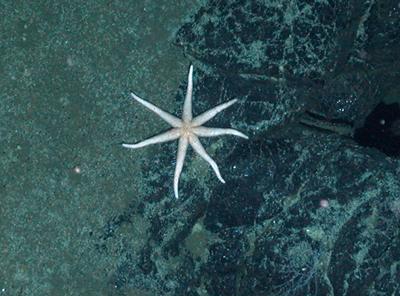New family of starfish named after Southampton marine biologist

A newly-discovered family of starfish species has been named after University of Southampton Professor Paul Tyler MBE.
Recent expeditions involving University scientists to undersea volcanic vents on the ocean floor near Antarctica led to the discovery of the new starfish family, named the ‘Paulasteriidae’, to honour the work of deep-sea biologist Professor Tyler, who recently retired from the University.
Professor Tyler led the Antarctic research programme that discovered these deep-sea vents and played a key role in creating the UK's Isis deep-diving remotely-operated vehicle (ROV) facility. Professor Tyler spent more time than any other British biologist directly observing marine life in the deep ocean and, for decades, inspired many students through his research-led teaching.
The new family – a larger branch in the ‘tree of life’ than a species - includes the first starfish species known to thrive at deep-sea volcanic vents. Previously, brittlestars – cousins of starfish – have been found at deep-sea vents, but not starfish species.
The research, which is published in the Zoological Journal of the Linnean Society, involved Ocean and Earth Science researchers Dr Jon Copley and Dr Leigh Marsh. The analysis was led by Dr Christopher Mah of the Smithsonian Institution and Louisiana State University in the USA using museum specimens and archived data.
Dr Jon Copley said: “Quite a few people have species named after them, such as Beyonce, John Cleese, Kate Winslet and Prince Charles, but having a larger branch of the ‘tree of life’ named after you is a rather more exclusive club. We are delighted to celebrate Paul’s contributions as a world-leading deep-sea biologist and inspiration to so many students over decades in this way.”

The difference between the new starfish family, which also includes another deep-sea species from the NE Pacific, and the starfish we are most familiar with from rockpools is their number of arms. Common starfish have five arms but the starfish at the Antarctic vents usually have seven arms – and they can grow to around 20 cm across.
The starfish live on rocks surrounding hot springs on the seafloor and feed on “Hoff" crabs, among other prey. In many other places in the ocean, starfish often get eaten by crab-like animals, but here the "Hoff" crabs appear to be slowed down by the cold Antarctic waters, making them easier pickings for the starfish.
Dr Copley adds: “Discovering a new family of animal life, and the first seastar species thriving at deep-sea vents, shows that there is still plenty of our world to explore, particularly in the ocean depths. So even after more than four decades of scientists exploring deep-sea vents around the world, we are still finding whole new families of species - and there may be more starfish species in this new family out there at other, as-yet-unexplored, deep-sea vents.”